Text
With the recent bleeding digital exoduses and all, now's as good a time as ever to summarize old posts and actually provide a clear, direct explanation of this old roguelike dev's current longterm project.

東方虚舟 ~ Sapphic Starseas Abyss is a work-in-progress deckbuilder roguelike defying the baggage of all those in Spire and Monster Train's wake. Repetitive thin decks with unthinking silo'd builds are heavily rejected, map traversal can reroute wildly over slowly illuminated nodes, and the mess of generic dungeon fantasy or cliche-riddled sci-fi gives way to a western cryptid incursion in a refuge for eastern myth. (Yes, this is also a Touhou fangame, beyond fandom memes and the first few Windows games.)
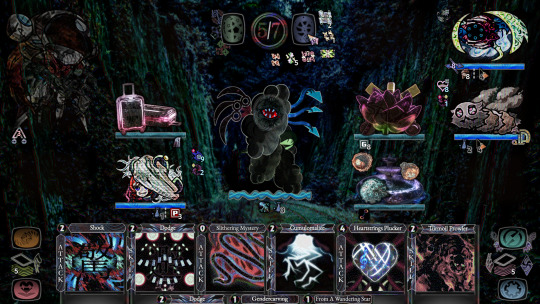
It's easy to promote without reflecting any real intention or direction. Even echoing off inspirations like Vault of the Void, Rift Wizard, Nowhere Prophet, and Brogue doesn't necessarily mean much. So, what exactly makes this stand out?
It's gay. Pre-run power-ups are now framed as choices of dates with monstrous women and ephemeral non-binary folk. The usual redundant or troublesomely dull neutral card pool here instead are slot-limited, uniquely build-specific, special-rarity Charm cards individually themed after and granted by kissing defeated bosses and minibosses. Queer colours radiate out from sparkles, cursors, icons, and passerby ghosts.
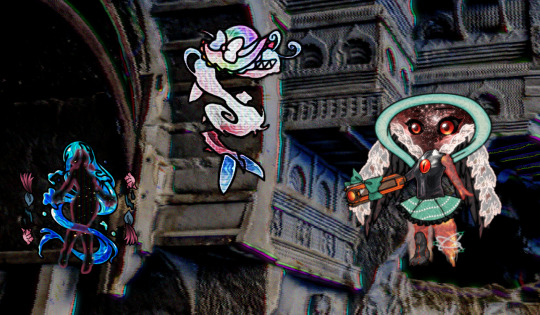
Fight complexity surpasses counting up defense vs. scaling vs. energy each turn. Gimmick obstacles and terrain on dual surrounding grids provide cover for enemies forecasted to come and go in delayed waves. Per-combat charges and travel-based cooldowns offer alternative uses for cards in hand or allow burst options beyond consumables hoarded for bosses. Between a first turn mulligan, in-game enemy pattern documentation, and freely preserving half of one's defense plus a single energy point and card each turn, one can prepare and plan past the muddling of memorization and luck.

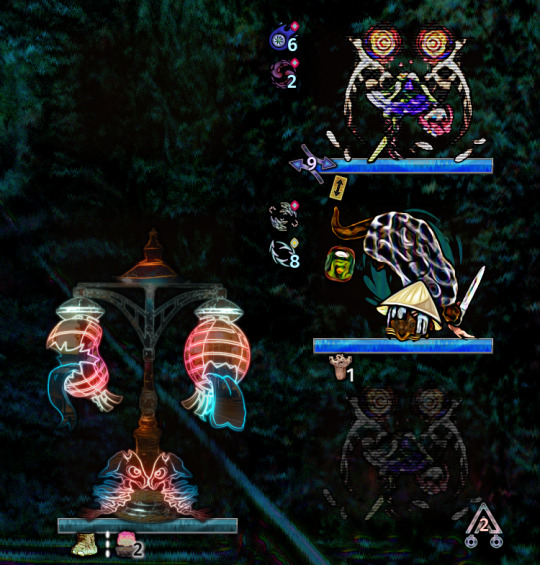
A distorted world of a caliginous collage. A fleet of western cryptids and aliens, fleeing contemporary racist conspiracy and carrying corruptive colonialist standardization, hijacked a space station ark and crashed into the borderlands of a previously hidden, now heavily destabilized eastern mythology sanctuary. In addition to monster girls are thus all sorts of creature encounters in combat, rest sites, marketplaces, and with the touch of short-term tidal boons and banes. The distortion zone in this game varies heavily from run to run, with different possible biome combinations for each chapter segment.

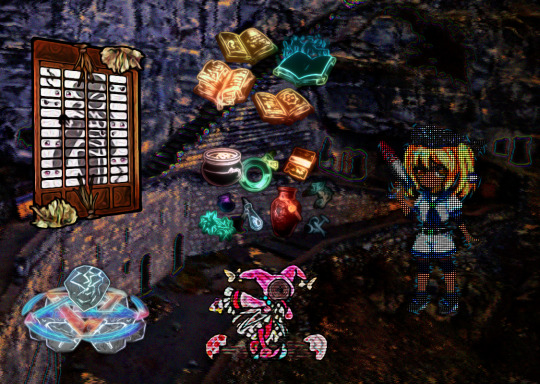
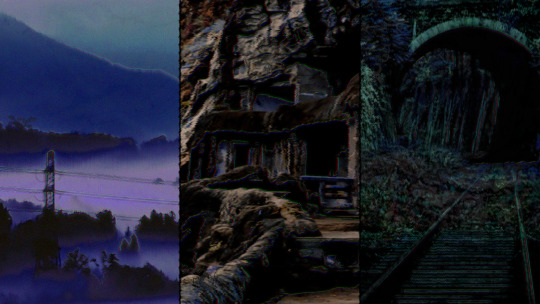
Notable iterations upon this format's conventions. Max energy gain is tied to adding new cards and removing starting cards, while removals are near-free so currency use can actually choose between new cards and passives and cooldowns that persist between shop visits. Players can deviate off the strict node path twice each zone, permitting changes of plans in the face of gradually revealed information of given node contents, trade-offs, and rewards. The cards themselves breach into a high sphere of dramatic intertwining.
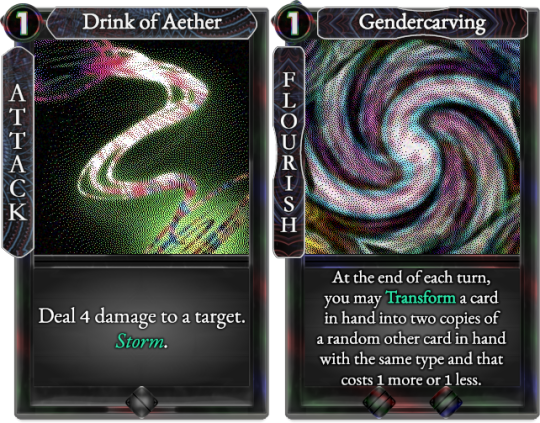
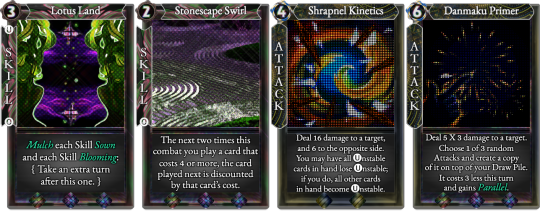

This project has admittedly been under work for years and will be in development for further years yet. Dozens of precise images sets each for dozens of different mechanics and an initial goal of ~300 cards have taken a while both. Still, if nothing else, I've been persistent in my quiet endless toil. Some year this'll be more than a contextless mirage.
[all 400+ rows of image credits.]
16 notes
·
View notes
Text
東方虚舟 ~ Sapphic Starseas Abyss has been in a bit of a slump. been trying to wrap up remaining ui graphic needs rather then getting lost in endless content art, but endless allergy rashes to a carpet beetle infestation and the outside wall of my apartment being
nearly completely replaced both have rather wrecked me. thus, I revisited the well of monsters for some more immediately tangible and gratifying individual piece work.
the queer gamedev life is one's girlfriend looking at end results and being kissed as her "little gay Frankenstein", in my experience. the goal is to be hyper-specific and impossible to replicate.

Mumbling Jubokku
A ravenous sproutling grown in bloodsoaked battlefields. With sufficient time and distance, even anthologists' forgeries - from Mizuki to Borges - end up with lives of their own.
Sizzling Tengubi
The skydancer society has various elemental phenomena attributed to them in remote rivers and mountains. This curious river-wisp surveys upon these complicated affairs in such waterlogged times.
Dharmic Waniguchi
The Myouren Temple's attempts at fresh devil deification will take ages yet. In the interim, innately religious beasts, like this gong-headed crocodilian, have begun to propagate their peaceful doctrines.
Shoji Duet
These two haunting heralds on sliding doors have formed both sorts a partnership. Together, this kage-onna and mokumokuren shift and project themselves whenever unseen, wherever they so wish.
Languid Globster
An amorphous mess of salt strands and flesh tendrils hides its exact form under a cetacean skull. These carcass-scrapings of Rorschach blots congeal around the broader public's fears of the sea's mystique.
been planning on expanding the use of these npcs, not that I'll say which of any of these also doubles as fights. random events providing buffs that last across map nodes affecting different groups of node types, retreating before battle or creeping in after battle, additional materials for open-book timed quiz material on IRL lore
(alongside all those length prior enemy descriptions), replacing wandering shopkeepers entirely to instead set up stalls in Chimata's markets, and the prior provisions of flavour of rest beyond campfires by eating / reading / brewing away. all sorts of attempts at non-generic worldsetting most (deckbuilder) roguelikes lack for these days…
(creditwork.)
13 notes
·
View notes
Text




The intermittent months and months of radio silence at a given time regarding progress on 東方虚舟 ~ Sapphic Starseas Abyss reflects one of my longest-held design theses.
Any work in most mediums takes a thousand talents smaller teams have to all brandish and large teams have to all coordinate; project and team management, audio / visual interface / effect coordination, dialoguework, motifwork, creature / costume / set design, narrative / exposition / scene / difficulty pacing and overhead, worldbuilding, copy-editing, budgeting, promotion, ad infinitum, forevermore. (Of course, mediums that don't express as many put higher burden on what remains.) Smaller groups take unconscious shortcuts and larger groups make vanilla compromises on weaker areas and budget-restrained aspects to get anything out at all under such weight, which contributes just as much as ambient pop culture does in producing generic slush. Straight-faced clichés of western fantasy settings, lacking options in character representation, cough, how many other deckbuilders on Steam use unaltered monochromatic Rexard and Poneti icons, cough cough, all the roguelikes with two or less songs while thousands of options have CC-BY licenses on Bandcamp, etcetera. The consequences of not using such have their own immense burdens; I've spent three years learning GIMP and G'MIC-Qt simply because I wanted my roguelike to not be 16-bit or otherwise be full of fuzzy abstract programmer art. My lack of restraint here thus meant working up and down the creative commons for thousands of needed assets, for UI bits and enemies and obstacles and status effects and other effects and card art and manifold collectible boosts. So it goes. The part where everything hasn't come together yet playability-wise further obscures this endless toil. It's hard for posting about games to spread without character melodrama or hot bodies or reflection and anecdotes, so all of these random contextless aesthetic + system samplings rarely stick.
...Having said all that, have some contextless vfx gifs from the hundreds I've worked away on. Gotta work with this aforementioned state of mostly being Aesthetic. Most of such are derived from the offerings of CuteStockFootage, KotatsuAkira, and pimen, if severely distorted in the fuzzy darkness that readily binds disparate sources together. (More works should really learn to do that.)
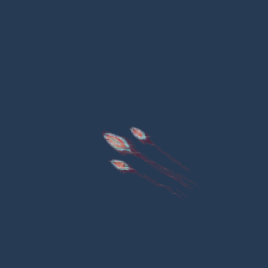


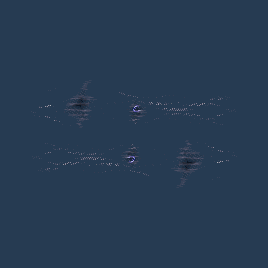
9 notes
·
View notes
Text
It turns out depression can be a real impediment to getting things done. Who knew?
7 notes
·
View notes
Photo

Surprisingly ominous message to come back to after being interrupted mid-sentence many hours ago and forgetting what I was actually planning to say.
4 notes
·
View notes
Text
(Her name is Reverie Sugarplum, by the way, and she has a lot to answer for.)
5 notes
·
View notes
Text
So many card effects and descriptions in my game have gotten changed over and over again for debugging and testing purposes and just never changed back that by this point, approximately every single piece of text visible in my UI is a blatant lie. The enemy spellcard targeting indicator doesn’t match the spellcard’s own description and neither matches what it actually does anymore. Player spellcards get two separate descriptions and they’re both lies. And I mean, look at this:
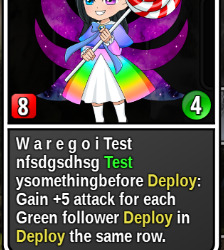
That isn’t her name, she’s not actually blue, and she can’t actually W a r e g o i anyone at all.
#Touhou#Gamedev#I swear I'm not disorganized#There's just 20 million things to be doing and I haven't gotten to this yet
4 notes
·
View notes
Photo
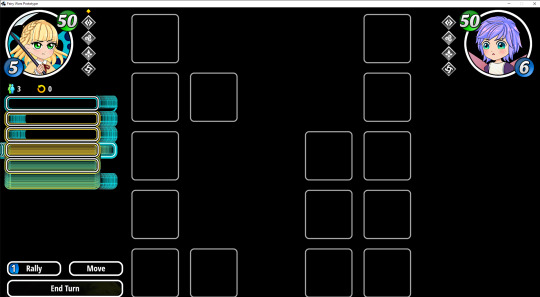
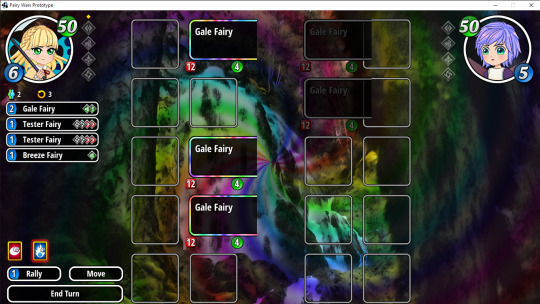
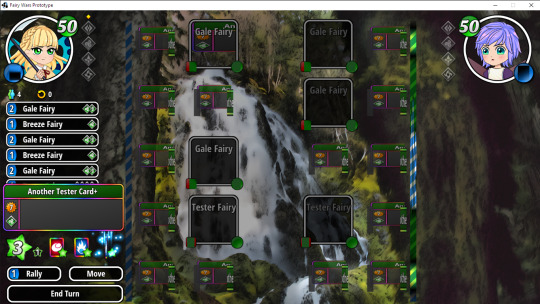
Also, I keep coding nice-looking UI animations that turn out not to capture very well, so in lieu of sharing what I’ve actually been working on lately, have a couple screenshots of old graphical glitches that I just stumbled onto again.
2 notes
·
View notes
Text
Y’know, there may have been a slight flaw in my plan of “Take a break from coding UI by coding a different UI”
1 note
·
View note
Text
Y’know, it would be really useful to have a working title for this game project that I can actually tag things with. Because the one I’ve been using MYSELF for ages is just ‘Fairy Wars’, but actually tagging anything public with that would be... misleading.
(I actually had a candidate for an *actual* game title at one point, but the plot context has changed enough since its inception that I’m not sure that even works anymore.)
2 notes
·
View notes
Video
Finally, enemy leaders can also throw spellcards at you!
Took quite a lot of iteration to figure out how to make this look punchy without giving myself an overwhelming vfx burden for the total number of enemy spellcards the game will eventually need to have. But scrolling background effects like this, I think I can manage.
(I apologize for the video quality, which I expect tumblr will inevitably mangle. This kind of visual effect seems to be *exactly* the sort of thing video codecs hate. I promise it looks much more slick in the game itself ^^; )
3 notes
·
View notes
Text
Y’know... I have a really simple tool for making video clips out of tiny bits of the screen, but it caps at 30 fps. To get a 60 fps recording of that, I went to considerably more trouble... only to notice that tumblr appears to have reduced it down to 30 fps on its own anyway.
Welp.
0 notes
Video
More fun things to do with speech balloons.
6 notes
·
View notes
Text
Y’know, part of the problem of going over a year without posting is that even after you come back, you still kinda forget that it’s a thing you could do, if you wanted to.
1 note
·
View note
Photo
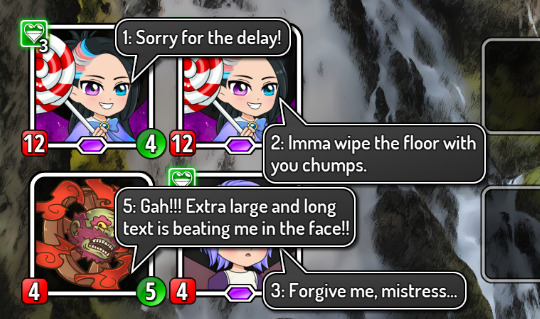
Adventures in automated speech balloon layout
5 notes
·
View notes
Text
roguelikes Index played in the last month and a half
The deathgames sale on Steam has coincided with me re/playing a decent pile of roguelike / hybrids over the past month and a half. While I’m not much in the mood for explicit reviews and recommendations over reflections, I’ve had a long time and sampling space to partake of and meditate over the procgen permadeath’s dynamics and possibility spaces, as defines my first and my latest gamedev endeavours. As such, there’s a given musing’s approach borne out of the each of them here, from whatever mountaintop hermit’s perspective I use.
(Games covered: Wizard of Legend, One Step From Eden, Crypt of the Necrodancer, Cogmind, Orbital Bullet, Night of the Full Moon, Devil Slayer Raksasi, Caves of Qud. Some mild screenshot spoilers…)
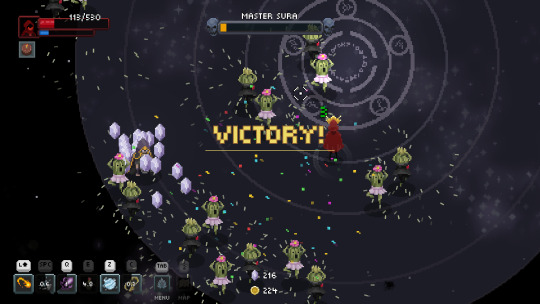
Wizard of Legend (2018) has its own orthogonal design swimming against the current. Many action roguelikes centralize on a few shifting weapon movesets or a few core verbs paired with a few strategic options. Said wizards here lean on over two hundred options of spell actions to fill six buttons with cooldowns, and brandish explicit armor outlining for ranged target selection and closed-quarters comboing down- quite a ways cleaner than many unmentioned and untuned leaning on short pokes and i-frame abuse. (Really, there’s a lot more in vulnerable dashes than readily plumbed, c.f. Hollow Knight.) Given individual runs thus inherit a bit more distinction (if not flux) compared to many unfocused on breadth of direct player actions, and slide in nicely with a decent mixable and scaling enemy and boss sets well even with a visibly limited asset budget. Such mix-ups are more lacking on starting builds or the standard passive perk accumulation, beyond curses or the disappointing stretching out of metaprogression currency, but for some given number of wins there’s a strong variant on the format to be had.
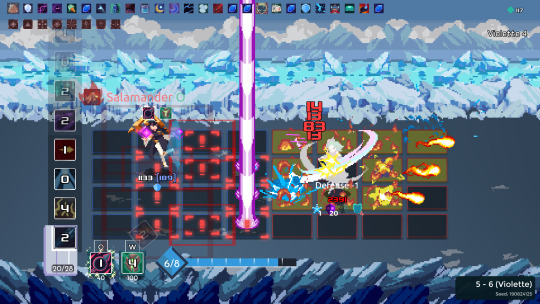
I’ve come around on One Step From Eden (2020). It is one of a slim few games brandishing a certain micro-grid card-churn action grown from Mega Man Battle Network’s moss-coated skeleton, and pushes such with a certain ravenous yet curious nature. Many action roguelikes thrive in a rapid twitchy manner, reliant on dodges and low total permitted injuries. While Eden’s pace is much faster than its origins and most games in the market, the discrete grids allow for shaped forewarnings that a lot of pattern recognition kick in and reshape instinct. It pairs curiously with one of the few explicit assist modes I’ve seen for a roguelike and the only one of them I’ve seen outright recommended for others, and a deckbuilding style where frequent choices start to boil down to “is this worth extra vulnerability of defense or stopping to aim” plus hybridizing up some duo of signposted supported keywords. (Unfortunately, a bunch of the most interesting build-arounds and synergies pop up a little ways into metaprogression, or half way up the ascension system, or only nine months after the initial release- the last of which made me take a long while between initial acquisition’s play and current Hell Pass 14 completion.) It took a long while for me to get back into it, and while difficulty is a nightmarish discourse it’s unavoidable that this game is set to backbreaking levels. Still, there’s little like it around, and such fusions set in such ruthlessness feel like a breath of fresh air after a hundred-year storm.

The rhythm roguelike Crypt of the Necrodancer (2015) barely needs any introduction, with its unique notion of actions mapped to beats then forged around strictly-patterned encounters presenting pressing questions how to handle bundles of half a dozen different discrete behaviours at once. There’s a certain clarity of focus borne out of said behaviours being predictable but timed in a game with short and fast runs- there’s more enemy varieties in the pre-dlc final zone than many games unmentioned here (and some mentioned here still) manage throughout their whole lengths. Plus, at a time where much of procgen level design has dissolved into canned room gauntlets without variety of terrain or spatial bleedthrough the digging system set in simple caves catacombs make for more memorable layouts than even the old titans’ regularly manage. I do have duly note, however, that after pushing available content to my furthest capacities, the characters I play are restricted down to those who die the least easily (Melody’s easy armor access, Nocturna’s parrying access)- while there’s many meaningful options for quite a few equipment slots, the damage numbers also just let you die in one or two specific hits for most of a 10 to 20 minute run. Probably better than face-tanking being the norm, but painful nonetheless.

Cogmind (2017+)is… noticeably, the only game I haven’t beaten on this list, and one of two classical format games on this list. Without community interacting or lurking it’s quite hard to learn the depths of either without a hybrid’s other genre execution to help assess matters, in terms of warding off death or finding what actually distinguishes and qualifies the given game. Here, the simulationist options and modularity of provided strategies are dense in the extreme, to both its merit (over a dozen relevant things to risk at each terminal! shed your weighty armor and limbs for new ones as they rot or you flee!) and its detriment (death and generative life are both great teachers neglected in the hybrid sphere, but there’s a lot of wiki reading to even learn of most unspoken options). The alert level and part fragility both contribute well to not fighting everything compared to most of these games, which also helps provide a sense of re-pacing, but when given fights can slaughter those bleeding out it’s exhausting Some day I’ll succeed in rhizome maneuvers, and learn to best walk through walls as a helicopter with a bazooka. (Also, the graphics are kind of always this small, as an unavoidable product of the game’s own terminal use. The monochromatics approach mostly hurts on sufficient part piles and which decor machines explode, though some definitely just can’t read the game at all- though, accessibility-wise, plenty can’t read the faster games on this very list, anyway. No need is an island.)
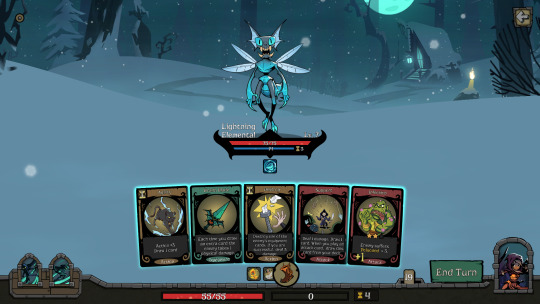
Night of the Full Moon (2019) feels like something that fell out from a parallel timeline. The Dream Quest style of deckbuilder roguelike was highly muted in Slay the Spire’s wake, though a few still march forward on it- centered on the core notion of enemies having their own deck and unseen hands pushing on severe build-countering gimmicks rather than direct action intent patterns. In abstract, this would allow more bluffing, more distinction, and more memorability for being blown out one way or another- in practice, without a stack, a board state, or explicit incoming threat to react to (and no, pre-emptive hand attack doesn’t count), the opposing opacity feels 80% like that inaccurate reputation of card games boiling down to opposing instant games of solitaire grazing against one another. (Thanks, Master Duel.) It’s sad, as there’s a fair bit of undeserved dismissal in most of this particular genre intersection’s other outputs, and there’s a fair bit of build and map decision-making plus complicated sequencing available in much of what Full Moon is willing to do. It’s also got quite the clean look and actual flavor direction many in this lack for, when the eight billion myriad talents required to make games exist need for shortcuts and genre flavour is one of the first for most to shortcut. (In particular, originator Dream Quest itself is quite scribbly.) The translation’s awkwardness is almost impressively amusing on the regular for e.g. stilted translations clashing against surprisingly clean voice acting, or the absurd number of annoyingly-anchorless profile stories for countless encounters. Go beat up those townsfolk for no reason, Red.
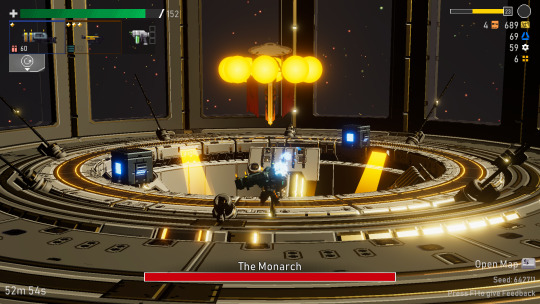
Orbital Bullet (2022) has a certain fresh style and strength while also speaking rather openly to some obvious core issues on the standard fitting of builds and the hyper-proliferation of metaprogression climbs. The nested-rings run-and-gun play is quite unique for 2.5d arrangements and shifts the parsing flow of enemy input and player output, and the ambushes for every room with such addresses a core issue many other 2d gunplay games possess of safe strats devolving into maintaining max distance with glacial increments forward. (Looking at you, 20XX.) This is tempered twice over, alas. I tend to despise a certain degree of metaprogression locking away core gameplay system- if random new sights are supposed to cover for death, then fully parsing systems is the same whether innate or gradually unlocked. Here, that includes fundamentals for pacing and run distinction between perk upgrading, healing access, challenge rooms, and combo streak rewards. This wouldn’t be completely damning if not for per-run strength gain also struggling- randomized skill tree offerings mostly concentrate on a quickly singular damage goal over the mild perks of others. It’s easier to say than it is to design “just make player plans adapt mid-run”, and swapping guns covers for a bunch of this, but it overall feels… weak on the overall roguelike front, where a briefer arcade spirit could have replaced extended cross-run grind for the better. Still solid on such shorter lengths, nonetheless.
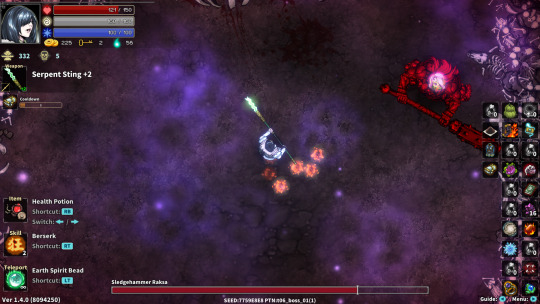
Devil Slayer Raksasi (2021) is centered on small amounts of action stamina, and thus counts closest as, gasp, a (top-down camera) soulslike. In such a welltrod and visible other half it unavoidably falters in still interesting fashions- for most followers in that fashion struggle hardest with what manages to be most cherished. Many roguelikes jarringly lack focus on encounter breadth for so many given runs, and despite hundreds of such foes drawn up they each lack for distinguishing factors beyond different frames and counts for swings. (While many players evidently dive in rather than out and around like as substantially eases dks1 and 2, any such kiting caution flattens most assaults- not an unreasonable lesson to learn for any stamina-centric game, but one more than established already.) Fromsoft is also more than glad to abuse poor lighting, thin paths, blind corners, rafter snipers, pressure plates, and all other sorts of viciousness lost to the clean floors and comfort food of hack & slash spectacle fighters, which this also lacks for. What it does manage to succeed at is baked into the title- with twelve+ zones and twenty+ bosses, there are in fact a fair number of unique devils to slay who do in fact have poise and art and gimmicks afforded to the each of them, and I have to wonder how well this also would have felt without the permadeath churn exposing the endless need of broad possibility space beyond exchanging swings.

I’m still deeply mixed on Caves of Qud (????), and it feels quite the shame and disconnect for the second-most recognizable game on this list still holding up a torch for the classical roguelike format. Even at the end of all of these musings I could probably write up an essay’s worth alone for this on how it’s a massive mismatch for a former dcss dev like myself- a maximalist sprawling open world akin to Elder Scrolls or ADOM that hyper-concentrates difficulty and interest into select spaces and otherwise frequently gets one literally mechanically lost in a dull wilderness or metaphorically lost in various fixed grinds. Back there we never agreed with the notion that systems-abusing grind like pudding farming is its own punishment, and that players have to be saved from themselves- contrariwise, many runs feel crushed down and slowed by the fixed offerings and strategies of mechanical wings, hologram / force bracelets, monetary exploits, and the start-independent option of crafting to reroll offerings for endlessly. It especially doesn’t help that emergency options beyond recoilers feel slim, and many things are more than glad to stone you dead quick. The actual interest targets have plenty of solid strength that’d carry things if not stuck in such a morass- the sheer hostility of unique terrain and fight gimmicks afforded to plot dungeons is quite strong in its own It also still has an unmatched style of prose, tangible acronym representatives, and a rarefied flavour of locale, all in a genre that struggles to. Probably this, alongside the deckbuilders I’ve sought out, is why I’ve spent the past two and a half years putting my money where my mouth is working on the writing and assets for my own roguelike of gay creatures in warped worlds.
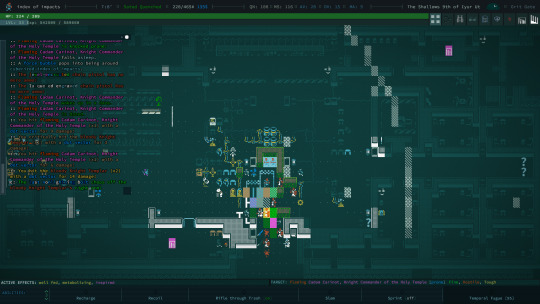
If I went a ways further back, there’d be plenty more I could ramble and muse upon, with lingering generosity for the each of them. Nowhere Prophet’s rich post-post-apoc desertpunk setting for one of the very few other polished creature-based deckbuilder rogues, Going Under’s invigoratingly bitter anti-work ethic blended with brutal destructible weapons action, and Shiren 5 still holding up an unmatched style and gimmick depths for the format’s old guard. There’s also most likely plenty to speak of further ahead- properly beating some CRYPTARK and Invisible Inc. campaigns; getting into Voidigo and Chrono Ark like my partner heavily recommends; acquiring and assessing Arboria, Brutal Orchestra, Rhythm Fighter, and Malice & Greed. There’s always so much to investigate in this combinatoric space, and such dynamics interplays demand a lot- but partial success is still interesting and supportive in and of itself, even if I could endlessly, vexingly, lovingly pick at the seams of each reality.
#Girlfriend words#I could write a LOT about various roguelikes I've played but it's hard to feel there's a lot of point to it most of the time#We're broadly on the same page here though
45 notes
·
View notes
Photo

kogabanki moment (suika is there too)
#Touhou#Kogasa Tatara#Sekibanki#Kogabanki has been steadily muscling in on Kogasana for me these last years#Umbrella can have little a second girlfriend as a treat
222 notes
·
View notes